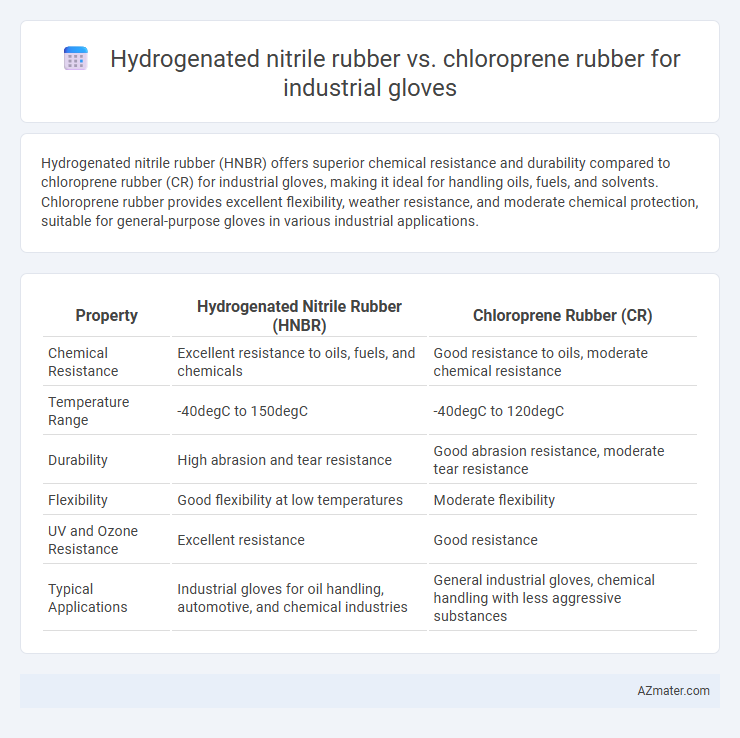Hydrogenated nitrile rubber (HNBR) offers superior chemical resistance and durability compared to chloroprene rubber (CR) for industrial gloves, making it ideal for handling oils, fuels, and solvents. Chloroprene rubber provides excellent flexibility, weather resistance, and moderate chemical protection, suitable for general-purpose gloves in various industrial applications.
Table of Comparison
| Property | Hydrogenated Nitrile Rubber (HNBR) | Chloroprene Rubber (CR) |
|---|---|---|
| Chemical Resistance | Excellent resistance to oils, fuels, and chemicals | Good resistance to oils, moderate chemical resistance |
| Temperature Range | -40degC to 150degC | -40degC to 120degC |
| Durability | High abrasion and tear resistance | Good abrasion resistance, moderate tear resistance |
| Flexibility | Good flexibility at low temperatures | Moderate flexibility |
| UV and Ozone Resistance | Excellent resistance | Good resistance |
| Typical Applications | Industrial gloves for oil handling, automotive, and chemical industries | General industrial gloves, chemical handling with less aggressive substances |
Introduction to Industrial Glove Materials
Hydrogenated nitrile rubber (HNBR) offers superior chemical resistance and durability, making it ideal for industrial gloves used in harsh environments with exposure to oils, solvents, and extreme temperatures. Chloroprene rubber (CR), known for its excellent flexibility, moderate chemical resistance, and good abrasion resistance, provides reliable protection in applications involving mechanical wear and moderate chemical exposure. Both materials balance performance and comfort, with HNBR excelling in high-stress chemical settings while CR suits versatile industrial glove requirements.
Overview of Hydrogenated Nitrile Rubber (HNBR)
Hydrogenated nitrile rubber (HNBR) is a high-performance elastomer known for its excellent chemical resistance, superior heat stability up to 150degC, and exceptional mechanical properties, making it ideal for industrial gloves used in harsh environments. Compared to chloroprene rubber, HNBR offers improved resistance to oils, fuels, and oxidizing agents, along with enhanced tensile strength and abrasion resistance. These characteristics provide longer glove durability and reliable protection in industrial applications involving solvents and chemical exposure.
Overview of Chloroprene Rubber (CR)
Chloroprene rubber (CR), commonly known as Neoprene, offers excellent chemical stability and flexibility, making it an ideal material for industrial gloves exposed to oils, chemicals, and extreme temperatures. Its superior abrasion resistance, ozone resistance, and good tensile strength provide durable protection in harsh industrial environments. Compared to hydrogenated nitrile rubber (HNBR), CR is more versatile in handling a wider spectrum of chemicals and maintaining performance in diverse temperature ranges.
Mechanical Strength Comparison
Hydrogenated nitrile rubber (HNBR) offers superior mechanical strength compared to chloroprene rubber (CR), demonstrating higher tensile strength typically ranging from 20 to 30 MPa versus CR's 10 to 20 MPa. HNBR exhibits enhanced abrasion resistance and better elongation at break, making it ideal for heavy-duty industrial gloves subjected to intense mechanical stress. The superior fatigue resistance of HNBR ensures longer glove life under repetitive flexing, outperforming chloroprene in durability and overall mechanical performance.
Chemical Resistance Differences
Hydrogenated nitrile rubber (HNBR) offers superior resistance to a broad spectrum of chemicals including oils, fuels, and aliphatic hydrocarbons, making it highly effective for industrial gloves exposed to harsh chemical environments. Chloroprene rubber (CR), while resistant to weathering, ozone, and moderate chemical exposure, generally lacks the enhanced solvent resistance that HNBR provides, particularly against aromatic hydrocarbons and acids. Choosing between HNBR and CR for gloves depends on the specific chemical exposures, with HNBR favored for aggressive chemical resistance and CR preferred for general durability and flexibility.
Temperature Stability and Performance
Hydrogenated nitrile rubber (HNBR) offers superior temperature stability, maintaining performance between -40degC and 150degC, making it ideal for industrial gloves exposed to extreme heat and cold. In contrast, chloroprene rubber (CR) performs effectively within a narrower temperature range of -30degC to 120degC but provides excellent resistance to oils and chemicals. HNBR's enhanced thermal resistance and mechanical durability ensure prolonged glove lifespan in demanding industrial environments compared to chloroprene rubber.
Flexibility and Comfort in Glove Applications
Hydrogenated nitrile rubber (HNBR) offers superior flexibility and enhanced comfort in industrial glove applications due to its excellent elasticity and resistance to compression set, allowing prolonged wear without discomfort. Chloroprene rubber (CR), while also flexible, tends to be heavier and less elastic than HNBR, which can reduce dexterity and overall comfort during extended use. HNBR's balance of flexibility, chemical resistance, and durability makes it a preferred choice for gloves requiring high performance and wearer comfort in demanding industrial environments.
Longevity and Durability in Industrial Use
Hydrogenated nitrile rubber (HNBR) exhibits superior chemical resistance and thermal stability compared to chloroprene rubber, resulting in enhanced longevity for industrial gloves used in aggressive environments. Chloroprene rubber offers excellent abrasion resistance and flexibility but tends to degrade faster under exposure to oils and solvents, reducing its overall durability. Industrial gloves made from HNBR provide a longer service life and maintain mechanical integrity in harsh conditions, making them ideal for heavy-duty applications.
Cost Analysis: HNBR vs Chloroprene
Hydrogenated nitrile rubber (HNBR) gloves generally exhibit higher raw material and production costs compared to chloroprene rubber gloves, driven by HNBR's enhanced chemical and thermal resistance properties. Chloroprene rubber gloves offer a more cost-effective solution for general industrial applications due to lower synthesis expenses and wider availability. When selecting gloves based on cost efficiency, chloroprene rubber remains the preferred choice unless HNBR's superior durability and protection justify the premium investment.
Choosing the Right Rubber for Industrial Gloves
Hydrogenated nitrile rubber (HNBR) offers superior chemical resistance, abrasion durability, and heat tolerance, making it ideal for industrial gloves used in harsh environments involving oils and solvents. Chloroprene rubber (CR), known for its excellent flexibility, weather resistance, and moderate chemical protection, suits gloves for general-purpose applications requiring resilience against ozone and aging. Selecting the right rubber depends on specific workplace hazards, with HNBR favored for high-performance chemical tasks and CR preferred for ergonomic comfort and broad environmental resistance.

Infographic: Hydrogenated nitrile rubber vs Chloroprene rubber for Industrial glove
 azmater.com
azmater.com